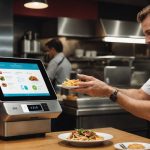The kitchen is often the heart of the home, but it can also be a source of hazards. IoT devices offer promising solutions to enhance safety while cooking. From smart smoke detectors to connected thermostats, technology can help prevent accidents before they happen. This exploration of IoT applications aims to empower you with insights and practical strategies for creating a safer culinary environment. Embrace innovation and transform your kitchen into a secure space where creativity flourishes without the risk of danger.
Overview of IoT in Kitchen Safety
In today’s modern kitchens, IoT kitchen technology plays a crucial role in enhancing safety and efficiency. By connecting appliances and devices to the internet, IoT enables seamless communication and control, transforming ordinary kitchens into smart cooking environments. This connectivity allows users to monitor and manage their kitchen safety devices remotely, ensuring a safer cooking experience.
Have you seen this : Chic Ways to Integrate Acoustic Panels into Your Kitchen Design
Smart cooking is revolutionized by IoT, as it offers real-time alerts and data analysis, helping to prevent accidents and improve kitchen management. For instance, IoT-enabled smoke detectors can send notifications to your smartphone, allowing you to respond promptly to potential hazards. Similarly, smart ovens can be programmed to shut off automatically if left unattended, reducing the risk of fires.
Common kitchen safety devices include smart thermostats, which regulate cooking temperatures to prevent overheating, and smart gas leak detectors, which alert users to potential leaks. These devices not only enhance safety but also contribute to energy efficiency and cost savings.
Also to see : Unlocking Natural Light: The Impact of Your Home”s Orientation on Kitchen Illumination
Embracing IoT kitchen technology is not just about convenience; it’s about creating a safer, more efficient kitchen environment. By integrating these devices, homeowners can enjoy peace of mind knowing that their kitchen is equipped with advanced safety features.
Key IoT Devices for Kitchen Safety
Exploring the realm of smart appliances and safety monitoring systems in the kitchen unveils a variety of IoT cooking gadgets designed to enhance safety and convenience.
Smart Smoke Detectors
Smart smoke detectors are pivotal in safety monitoring systems. They connect to your smartphone, offering real-time alerts if smoke is detected. This immediate notification system is crucial for preventing potential kitchen fires. Users praise their reliability and ease of integration with existing smart home setups. Brands like Nest and First Alert lead the market, offering high user satisfaction due to their advanced features and consistent performance.
Smart Ovens
Smart ovens are transforming cooking experiences by incorporating IoT technology. These ovens can be programmed to shut off automatically, preventing accidents caused by unattended cooking. Users appreciate the convenience and safety these devices offer, with brands like Samsung and Bosch receiving positive reviews for their innovative features and user-friendly interfaces.
IoT-enabled Thermometers
IoT-enabled thermometers provide precise temperature monitoring, ensuring food is cooked safely and efficiently. They connect to apps, allowing users to track cooking progress remotely. Brands such as Meater and Weber offer models with high accuracy and durability, garnering favourable reviews for their practicality and ease of use.
Benefits of Integrating IoT Devices
Integrating IoT devices into your kitchen offers numerous benefits, primarily focusing on enhanced safety, convenience, and cooking efficiency. These smart technologies significantly reduce kitchen accidents and hazards by providing real-time monitoring and alerts. For instance, smart smoke detectors and gas leak detectors notify users instantly, allowing timely interventions to prevent potential disasters.
The convenience of IoT devices is unparalleled. With the ability to control and monitor appliances remotely, users can manage their kitchen activities seamlessly. Smart ovens and IoT-enabled thermometers ensure precise cooking by allowing users to track cooking progress through their smartphones, thus enhancing the overall cooking experience.
Moreover, IoT devices contribute to cooking efficiency by saving time and improving accuracy. Automated functions, such as pre-set cooking modes and temperature controls, ensure that meals are cooked perfectly without constant supervision. This not only minimizes the risk of overcooking or undercooking but also allows users to focus on other tasks, making meal preparation more efficient.
In summary, the integration of IoT devices in the kitchen not only enhances safety and convenience but also optimizes cooking processes, providing a smart and efficient culinary environment.
Installation and Setup of IoT Devices
Integrating IoT devices into your kitchen requires careful planning and execution. Follow a setup guide to ensure a smooth installation process.
Step-by-Step Installation Process
- Choose Compatible Devices: Ensure the IoT device is compatible with your existing kitchen appliances. This prevents integration issues later.
- Follow Manufacturer Instructions: Refer to the device’s manual for specific installation steps. This often involves connecting the device to your home Wi-Fi network and downloading the corresponding app.
- Positioning: Place devices like smart smoke detectors and thermometers in optimal locations for accurate readings and effective operation.
Tips for Seamless Integration
- Network Compatibility: Ensure your Wi-Fi network is reliable and has sufficient bandwidth to support multiple devices.
- Smart Kitchen Integration: Use a central hub, like a smart speaker, to control all devices from one interface, simplifying management.
Troubleshooting Common Issues
- Connectivity Problems: Restart your router or move the device closer to the Wi-Fi source.
- App Syncing Issues: Reinstall the app or check for updates to resolve syncing problems.
- Device Malfunctions: Reset the device to factory settings and repeat the installation process.
By following these steps, you can effectively integrate IoT devices into your kitchen, enhancing safety and efficiency.
Best Practices for Utilizing IoT in the Kitchen
Implementing IoT technology in your kitchen offers numerous benefits, but it’s essential to follow best practices to maximize safety and efficiency. Start with daily safety checks and maintenance of IoT devices. Regularly inspect devices like smart smoke detectors and gas leak detectors to ensure they’re functioning correctly. This proactive approach helps in identifying potential issues before they become serious problems.
Managing notifications and alerts is crucial for optimal usage of IoT devices. Customize alert settings based on your preferences and schedule. This ensures you receive timely updates without being overwhelmed by unnecessary notifications. For instance, set your smart oven to alert you only when cooking is complete, rather than at every stage.
Incorporate practical cooking tips when using IoT technology to enhance your culinary experience. Utilize smart cooking practices, such as pre-programming cooking modes for your favorite dishes. This not only saves time but also ensures consistent results. Additionally, make sure to familiarize yourself with IoT device management features, like remote control and monitoring, to take full advantage of the convenience offered by these smart technologies. By adopting these practices, you can create a safer, more efficient kitchen environment.
Case Studies and Real-Life Applications
Exploring IoT kitchen success stories reveals how households have significantly improved safety and convenience. One notable example involves a family who installed smart smoke detectors and gas leak detectors after a near-miss incident. The IoT devices provided real-time alerts, allowing them to address potential hazards promptly and avoid a potentially dangerous situation.
Another compelling case is a home equipped with smart ovens and IoT-enabled thermometers. These devices have transformed their cooking practices by offering precise control and monitoring. Users have shared positive experiences, noting how these technologies prevent overcooking and ensure food safety. The convenience of managing cooking processes remotely has been particularly appreciated, leading to more efficient meal preparation.
User experiences highlight the transformative impact of IoT in the kitchen. Many have reported enhanced peace of mind, knowing that their homes are equipped with advanced safety features. Testimonials often mention the ease of use and seamless integration with existing smart home systems, making these technologies accessible to a wide range of users.
Through these real-life applications, it’s clear that IoT devices are not only enhancing safety but also improving overall kitchen management, providing practical solutions to everyday challenges.






